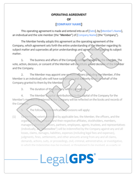Exit Strategies for LLCs With No Clear Buyer
Selling an LLC is easy when buyers are lined up—but what if there’s no one waiting to take over? Many business owners assume their company will be in...
8 min read
LegalGPS : Sep. 20, 2025
Key employee buyout agreements are contractual arrangements that give your most valuable employees the opportunity to acquire ownership stakes in your LLC over time. These agreements serve as powerful retention tools while creating clear pathways for employees to become invested partners in your business success.


Legal GPS Pro
Protect your business with our complete legal subscription service, designed by top startup attorneys.
Unlike traditional employee stock option plans used by corporations, LLC buyout agreements must navigate the unique structure of limited liability companies. They typically involve granting membership interests or profits interests to key employees based on performance metrics, tenure, or achievement of specific business milestones.
Standard equity plans often focus on broad-based employee participation with uniform vesting schedules. Key employee buyout agreements, however, are highly customized arrangements designed for your most critical team members. They usually include more complex valuation mechanisms and stronger buyback provisions to protect the LLC's interests.
These agreements also tend to be more restrictive about transferability and include detailed provisions about what happens when employees leave the company. The goal is rewarding loyalty while maintaining control over who becomes a member of your LLC.
Your best employees are constantly being recruited by competitors, especially in today's tight labor market. Key employee buyout agreements create "golden handcuffs" that make it financially painful for top performers to leave before their ownership interests fully vest.
These arrangements also solve a common problem for growing businesses: how to reward exceptional employees when cash bonuses aren't enough, but you're not ready for a full ownership transfer. Buyout agreements let you share future success without giving up immediate control.
Many LLC owners use key employee buyouts as part of their long-term succession planning. By gradually transferring ownership to proven employees, you create internal buyers who understand your business intimately and have strong incentives to maintain its success.
This approach often works better than selling to outside buyers because key employees are already invested in your company culture and operational systems. They're also more likely to preserve jobs for remaining staff members.
When employees have ownership stakes with multi-year vesting schedules, they think twice about job offers from competitors. The financial cost of walking away from unvested interests often exceeds the benefits of slightly higher salaries elsewhere.
This protection becomes even stronger when your buyout agreements include non-compete clauses tied to ownership benefits. Employees who violate these restrictions typically forfeit their ownership interests entirely.

Key Employee Buyout Agreement
Looking to reward and retain top talent? A Key Employee Buyout Agreement lays out terms for an employee to gradually purchase equity paving the way for future leadership and ownership transition.
Trusted by 1,000+ businesses to safeguard their LLCs.
Every key employee buyout agreement should specify exactly how ownership interests will vest over time. Most successful programs use performance-based vesting combined with time-based requirements to ensure employees earn their stakes through continued excellence.
Common vesting structures include four-year schedules with one-year cliffs, meaning employees must stay at least 12 months before any ownership vests, then receive quarterly or annual vesting thereafter. Performance metrics might include revenue targets, client retention rates, or specific project completions.
Your agreement must establish clear methods for determining the value of ownership interests both when granted and when employees eventually sell. Many LLCs use annual third-party appraisals, while others rely on formulas based on revenue multiples or book value.
The pricing formula should also address how employees will pay for their interests. Some companies allow cashless exercises where employees receive the appreciation value without paying the original grant price. Others require full payment but offer financing assistance or payroll deduction plans.
Strong buyback provisions protect your LLC if employees leave before fully vesting or violate their employment agreements. These clauses typically give the company the right to repurchase ownership interests at predetermined prices, often below fair market value for departing employees.
Restrictions on transferability ensure that ownership interests can't be sold to competitors or outside parties without company approval. Most agreements include rights of first refusal, meaning the LLC can match any outside offer for an employee's interests.
Sarah's software development company created a three-tier system for key employee buyouts. Senior developers could earn up to 2% ownership over four years, team leads could earn up to 3%, and department heads could earn up to 5%. Each tier had different performance requirements and vesting schedules.
The company used a hybrid approach where 50% of ownership vested based on time and 50% vested based on hitting specific performance milestones like code quality metrics and project delivery deadlines. This structure kept employees focused on both longevity and excellence.
After three years, the program helped Sarah retain 95% of her key employees while competitors in her market struggled with 40% annual turnover rates. The ownership stakes created a culture where employees thought like owners, leading to better decision-making and customer service.
Start by identifying which employees are truly essential to your business success. These are typically people whose departure would significantly impact operations, client relationships, or revenue generation. Limit your initial program to no more than 10-15% of your workforce to maintain exclusivity.
Consider creating different tiers based on job roles and seniority levels. This approach lets you offer meaningful ownership stakes to various employees without giving away too much equity too quickly. It also creates natural progression paths as employees advance in their careers.
Most successful programs use 3-5 year vesting periods with annual or quarterly milestones. Shorter periods don't provide enough retention value, while longer periods can feel too distant to motivate employees effectively.
Performance milestones should be challenging but achievable, tied directly to business outcomes you care about most. Avoid metrics that employees can't directly influence, like overall market conditions or regulatory changes that affect your industry.

The biggest mistake LLC owners make is overcomplicating their buyout agreements with excessive performance metrics and vesting conditions. Employees need to understand exactly what they must do to earn ownership, and complex formulas create confusion rather than motivation.
Another critical error is failing to plan for different exit scenarios. Your agreement should clearly address what happens if employees are terminated for cause, become disabled, die, or if the entire company is sold. Ambiguity in these areas leads to expensive legal disputes later.
Mike's manufacturing LLC granted ownership interests to three key employees using a valuation formula based on annual revenue. When the company had an exceptional year due to a one-time government contract, the formula produced unreasonably high values for the employees' stakes.
The employees expected to cash out at these inflated values, but the company couldn't afford the buyback costs. The situation created resentment and legal threats that ultimately led to expensive settlements and the departure of all three employees.
This disaster could have been avoided with a more sophisticated valuation approach that considered multiple factors and included caps on annual increases. The lesson: simple formulas often produce unfair results in complex business situations.
Your buyout agreement should address voluntary departures, terminations for cause, disability, death, and company-wide sale transactions. Each scenario typically has different valuation methods and payment terms that reflect the circumstances involved.
Many LLC owners focus only on successful vesting scenarios and ignore what happens when things go wrong. This oversight leads to disputes when employees leave unexpectedly or under difficult circumstances.
LLC buyout agreements must comply with your state's limited liability company laws, which vary significantly across jurisdictions. Some states require specific consent procedures for admitting new members, while others have different requirements for ownership transfers.
Consider phantom equity plans as alternatives to actual ownership transfers. These arrangements provide employees with cash payments equal to the appreciation in company value without actually granting membership interests.
Phantom equity plans avoid many compliance complications while still providing meaningful incentives for key employees. They're particularly useful if you want to maintain simple ownership structures or if your operating agreement restricts new member admissions.
Federal tax implications can be complex depending on whether you grant actual membership interests or profits interests. Profits interests typically don't create immediate tax consequences for employees, while membership interests might trigger taxable events upon vesting.
Jennifer's consulting firm used profits interests tied to specific client accounts to reward her key account managers. Each manager received profits interests that would pay out based on the revenue growth and profitability of their assigned accounts over a three-year period.
This structure aligned employee incentives with client success while avoiding immediate tax consequences. The profits interests only had value if the managers grew their accounts profitably, creating strong motivation for excellent client service.
When one manager's accounts grew by 150% over two years, her profits interest generated a $75,000 payout that was taxed as capital gains rather than ordinary income. This tax-efficient approach made the rewards more valuable to employees while maintaining reasonable costs for the company.
Start with a pilot program involving just your most critical employees before expanding to broader groups. This approach lets you test your agreement terms and valuation methods on a smaller scale, making adjustments based on real-world results.
Establish regular communication schedules to keep employees informed about their vesting progress and any changes to company valuation. Quarterly updates work well for most businesses, providing enough frequency to maintain engagement without creating administrative burdens.
Consider annual meetings where you review the overall program performance and make adjustments based on business changes or employee feedback. Transparency builds trust and helps employees understand the value of their ownership stakes.
Document everything carefully, including the rationale for selecting specific employees, the performance metrics you've chosen, and regular updates on vesting progress. Good record-keeping prevents disputes and demonstrates fair treatment across all participants.
Tom's restaurant chain implemented key employee buyouts across five locations by starting with general managers and expanding to assistant managers after six months. Each manager could earn up to 3% ownership in their specific location based on profitability improvements and customer satisfaction scores.
The program included monthly coaching sessions where managers reviewed their performance metrics and received guidance on improving their results. This hands-on approach helped managers understand their impact on ownership value while building stronger operational skills.
After 18 months, locations with manager ownership stakes showed 23% higher profitability and 15% better customer satisfaction scores compared to locations without the program. The success led Tom to expand the program to kitchen managers and senior servers.
Your agreement should specify different buyback prices and payment terms depending on why employees are leaving. Voluntary departures might trigger buybacks at fair market value with extended payment terms, while terminations for cause might result in buybacks at book value with immediate payment requirements.
Include specific provisions for what happens if key employees become disabled or die before their ownership interests fully vest. Many agreements accelerate vesting in these circumstances while providing the LLC with buyback rights to maintain ownership concentration.
Consider purchasing key person life insurance to fund these buyouts, especially for employees with large ownership stakes. The insurance proceeds can provide immediate liquidity for the deceased employee's family while protecting the remaining owners from dilution.
Consider including "good reason" resignation clauses that treat certain departures like involuntary terminations. These might include situations where you significantly reduce an employee's responsibilities, cut their compensation, or require relocation to distant offices.
David's engineering consulting firm created a detailed buyback matrix that addressed six different departure scenarios with specific valuation methods and payment terms for each situation. The policy ensured fair treatment while protecting the company's interests.
For voluntary departures after full vesting, employees could sell their interests back at fair market value with payments spread over three years. For terminations with cause, the company could repurchase interests at 75% of book value with immediate payment.
The comprehensive approach prevented disputes because everyone understood the consequences of different departure scenarios. When one partner retired early, the predetermined process made the transition smooth and maintained positive relationships with all remaining owners.
Key employee buyout agreements involve complex legal and tax considerations that require professional guidance. Work with attorneys experienced in LLC structures and employee incentive programs to ensure your agreements comply with applicable laws and achieve your business objectives.
Consider engaging business valuation professionals to establish fair pricing methods and review your valuation approaches periodically. Proper valuation protects both your interests and your employees' interests while preventing disputes about ownership values.
Ready to start rewarding your key employees with ownership opportunities? Legal GPS Pro provides customizable LLC buyout agreement templates and expert guidance to help you structure effective employee incentive programs. Our templates include all the essential provisions discussed in this article, plus state-specific modifications to ensure compliance with your local requirements.
Don't let your best employees walk away to competitors. Start building loyalty and creating succession pathways today with professionally drafted key employee buyout agreements that protect your business while rewarding the people who make it successful.

Legal GPS Pro
Protect your business with our complete legal subscription service, designed by top startup attorneys.
|
Premium Template
Single-use Template |
Legal GPS Pro
Unlimited Access, Best Value |
|
|
| Choose Template | Learn More |
| Trusted by 1000+ businesses | |
Table of Contents

Selling an LLC is easy when buyers are lined up—but what if there’s no one waiting to take over? Many business owners assume their company will be in...

The entrepreneurial landscape has evolved dramatically, and so have exit strategies. Gone are the days when business owners had to choose between...

2 min read
When Mark's three-partner marketing agency faced an unexpected member departure in 2024, their hastily drafted operating agreement became their...